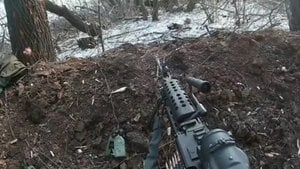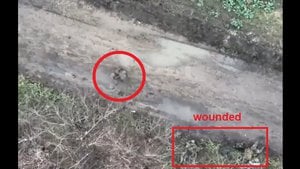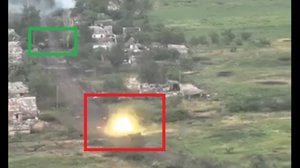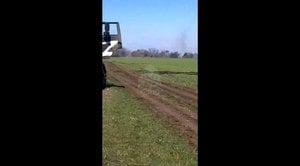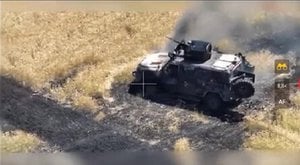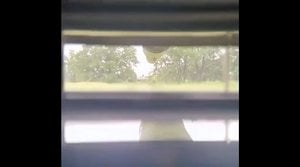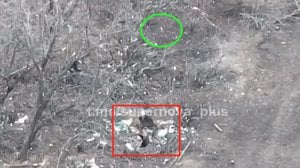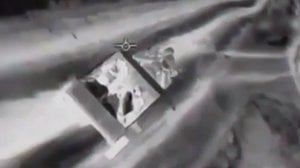
Mech Assault Devolves into Miserable Failure
Published 11 months ago
Footage of a Russian assault near Synkivka, Kharkiv Oblast, allows for some observations mechanized operations in this conflict. The drone reveals a BMP company in column charging through the trees, led by two tanks. The lead tank boasts a mine roller which performs as designed, detonating a mine as the tank continues forward, unperturbed. The lead BMP, following the second tank, attempts to plow through the mine crater, becomes mired, and is rear-ended by the next BMP in line. The tank equipped with the mine roller then splits to the right and egresses across an open field, and action that I initially interpreted as unplanned, but now think might have been an intention decision by the Russians intended to preserve the asset. The second tank then continues to the objective, firing as it advances, with most of the company in trace, but one BMP splits from the column and veers left. As it continues, unknown objects appear to fall from the vehicle.
From this point in the video the scheme of maneuver is difficult to comprehend. The lead BMP suddenly stops and allows its soldiers to dismount, though their objective is unknown. The next two BMPs pass it and continue forward, while the rest of the company is some distance behind, slowed by the mine crater. The BMP which took the lead in the main column also halts near a small structure, and the next vehicle in line continues on in trace of the lead tank. The BMP which split to the left stops briefly to deposit its troops, but a mortar round lands nearby, which prompts the BMP crew to exit stage left with soldiers still falling from the vehicle.
The remaining vehicles continue on to a larger structure which may well have been the primary objective, and here the attack appears to break down. The building is screened by a skeletal row of trees, and the tank and one of the BMPs pull up on the leeward side of the trees while a lone BMP charges up to the house and deposits its human cargo. Other BMPs arrive and the trail leading to the building quickly becomes clogged with vehicles and troops milling about and bumping into each other. The troops on the objective seem unsure of what they should do, and at least once a BMP nearly runs over one of its own dismounts.
The view shifts to an overhead perspective as a drone drops a munition into a mass of BMPs and soldiers milling about in confusion. The vehicles maneuver erratically as they attempt to clear the area, abandoning their infantry dismounts. As one vehicle turns around some infantrymen fall to the ground, and as it flees the area, one man desperately clings to the vehicle, is dragged and left by the roadside. With the Russian armor in flight, a Ukrainian IFV moves forward to see them off. A few Russian soldiers huddle against the building, abandoned by their comrades. Fixed in place by the IFV, they are flanked by Ukrainian infantry and eliminated.
There is a lot to unpack here, and it is worth noting what the Russians did well. They task organized well for this mission as the terrain clearly called for infantry, and reinforcing a BMP company with tanks was a sound move. They attempted to utilize speed and advanced quickly towards the objective. Equipping the leading tank with a mine roller was smart and withdrawing that asset from the field once its mission was fulfilled was also a good call. It also appears that there was an attempt to flank the objective, or to at least have some part of the attacking force approach along a parallel route, a good choice given that the road leading to the objective offered few opportunities for maneuver, but that maneuver was not well executed.
This was not a combined arms operation. It was a headlong charge with little in the way of supporting fires. There is no indication that the objective came under artillery or mortar fire, or that there was any attempt to silence Ukrainian guns through counter battery fire. The objective area should have been subjected to indirect fire as the assault force crossed the open area and cleared the mine field, and those fires should have continued as the Russians moved into their assaults positions and deployed their infantry. If artillery or mortar fire did support this attack, it was not well coordinated and was not directed in a manner that affected the outcome of the operation.
The integration of tanks and IFVs leaves much to be desired. Placing heavier and more heavily armored vehicles at the head of the column was the correct move to make, and the tanks could have influenced the outcome of this fight had then been better employed. The BMPs followed the tanks like a running back following a blocker, and then the tanks kept rolling into the labyrinth of trees and buildings, thus negating the advantages offered by their big guns. Had the tanks or tank split from the main body and assumed a support by fire position they might have suppressed the defenders in the objective area as the BMPs deployed their infantry. Instead, they became caught in the traffic snarl near the house and offered nothing except another target for Ukrainian gunners and drones.
The integration of tracks and infantry, and vehicle craft overall was lacking. U.S. doctrine prescribes deploying infantry at least one terrain feature away from an objective, or at least in a place that provides some cover from line-of-sight systems. I have noticed for some time a tendency by both sides in this conflict to dump their crunchies right on top of the objective, and while I tend to cringe a bit when I see it on screen, I am aware there are situations in which the terrain may offer few other options, though in those cases one would think that the objective would be suppressed in some form or fashion as the dismounts deploy. In this instance, troops were scattered haphazardly about the battlefield, including on the Ukrainians’ door step, in a manner that indicated little practice and even less care. Furthermore, one of the benefits of an Infantry Fighting Vehicle is that it can fight alongside the infantry it carries, but I aw no indication of that in this video.
As I watched this attack unfold, and then watched it again, I had the impression that someone developed a plan, but that very few members of the attacking force knew what that plan was supposed to be. If there was any nuance to the scheme of maneuver, any plan to envelop the Ukrainian position, to establish a support by fire, to divide the attacking force into support and assault elements – anything – those subtleties quickly fell to the wayside like a draftee dropped off he side of a BMP, and the effort devolved into a full-on, follow the man in front of you, Leroy Jenkins-type charge. What’s more, its was clear from the actions of the dismounting soldiers, the confusion in the objective area, and the twirling and bumping about and the vehicles as they scrambled to depart the area, that training was lacking and that confirmation briefs and rehearsals are nonexistent in the Russian army. This says as much about small unit leaders as does about the soldiers themselves. In the end, the attack was a rather embarrassing debacle, and the Russians were lucky to depart with relatively few losses. Except for the infantry they left behind.
About the Author

Cam
Cam served as an infantry officer in the Marine Corps, deploying to the Horn of Africa and participating in combat operations in Iraq. He currently works in the maritime industry and in the defense sector as an instructor of combined arms planning and operations. An avid sailor, Cam founded and directs Triumph Sailing, a nonprofit that supports veterans and first responders through adventure and fellowship on the water. Triumph Sailing just completed its big yearly event, an offshore race in the Gulf of Mexico with an all veteran crew. You can support the mission and next year's sailing season at Tri-Sail.Org.


